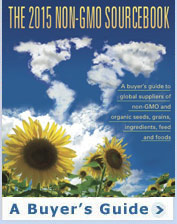Disturbing questions remain about GM flax contamination
Last September, the Flax Council of Canada (FCC) announced that an unapproved variety of genetically modified flax was detected in food products in Europe. The GM flax variety was identified as FP967 or 'Triffid,' which had been developed in Canada, but was never commercialized and has been illegal to grow in Canada since 2001. Since the initial announcement last September, GM flax contamination has been reported in 35 countries.
The contamination has decimated Canada's flax exports to Europe, which buys 70% of Canada's flax exports worth an estimated $321 million (Canadian). The European Union has zero tolerance for unapproved GMOs.
More than six months later disturbing questions remain about the GM flax contamination:
How did the contamination happen?
No one knows for sure how a GM flax variety that had been removed from the market eight years earlier ended up contaminating food products in 35 countries. According to the Canadian Biotechnology Action Network, by 2001, 40 seed growers were multiplying 200,000 bushels of GM seed for future demand. One theory is that some flax growers continued to grow the variety even after the Canadian flax industry decided not to allow commercial production of GM flax.
According to an article in the Manitoba Co-operator, extensive sample testing from across Canada's flax-growing regions found the Triffid contamination could not be isolated to one area. It was present in minute quantities throughout the system. Testing in March by Canada's Crop Development Centre found low levels of Triffid in seed used by flax breeders.
Triffid's developer Alan McHughen passed out packets of Triffid seed to farmers 10 years ago, but he says the packets contained only 30 seeds and were distributed with the provision that they wouldn't be planted for commercial use. 'It's impossible for the current contamination to be caused by these packets,' McHughen says.
Why did the Flax Council of Canada wait until September to acknowledge the contamination problem?
An FCC press release dated October 30, 2009 states 'In July 2009 a commercial laboratory in the EU detected a low level presence of genetically modified material in a shipment of Canadian flaxseed to the EU.' FCC made the contamination problem public in September.
But an industry source who wishes to remain anonymous told The Organic & Non-GMO Report that the FCC was first notified of the contamination problem in March 2009.
Calls and emails to Barry Hall, executive director of the Flax Council of Canada, to ask him about this and other questions were not returned.
Was another GM flax variety involved in the contamination?
There were several GM flax varieties, including FP968 that had been developed, according to Alan McHughen. Could one of these other varieties have been the source of the contamination? McHughen says this is unlikely. 'Triffid (FP967) had the most seed stock. There were only a couple of thousand pounds at most of the other varieties.'
Why was the lab that first discovered the contamination not included on FCC's list of labs approved to test for Triffid?
In January, FCC published a list of laboratories approved to test flax samples for the presence of Triffid. The laboratory that first discovered the contamination, Genetic ID, was not on the list of approved labs even though Genetic ID is listed on the Canadian Grain Commission's website as a laboratory proficient in testing flaxseed samples. An industry source said the exclusion of Genetic ID was 'an obvious attempt to shoot the messenger.'
Why hasn't FCC released an event-specific GMO test for Triffid after announcing in October that it would?
On October 9, 2009, FCC announced that the National Research Council Plant Biotechnology Institute and DNA Landmarks were developing a test that would detect the Triffid GMO 'event.' FCC said 'the organizations anticipate having a PCR protocol available for validation testing by October 15, 2009.' The protocol has not yet been released.
(Sources: CBC News, Manitoba Co-operator, Canadian Biotechnology Action Network)
(Copyright The Organic & Non-GMO
Report, May 2010)




